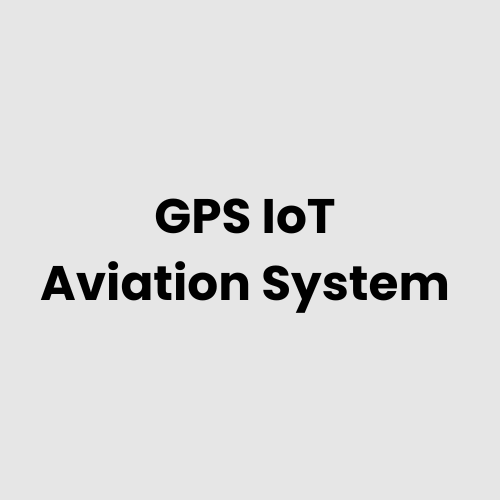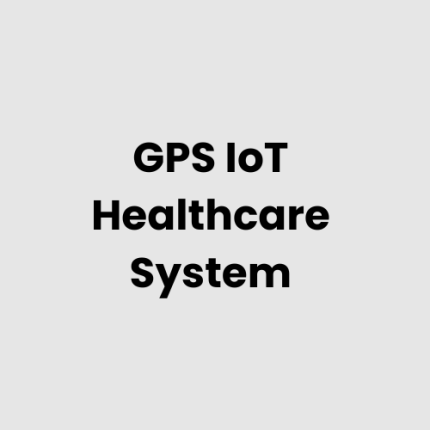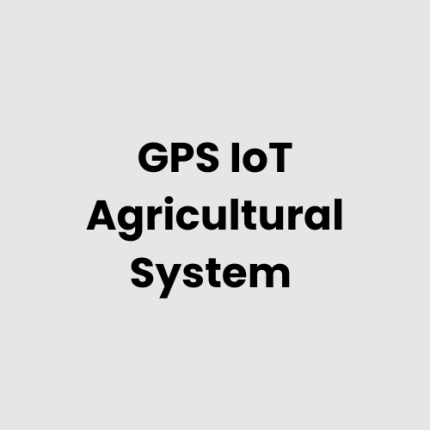Description
Technical Architecture
The GPS IoT Enabled Aviation IoT System integrates advanced GPS modules, IoT devices, and data management platforms to provide real-time monitoring and analytics for aviation operations. Its architecture includes:
- Edge Devices: IoT-enabled sensors and GPS trackers installed on aircraft and ground equipment for data acquisition.
- Communication Layer: Wireless protocols such as LoRa, 5G, and Wi-Fi for transmitting data between aircraft, ground stations, and control centers.
- Middleware: Centralized servers or cloud platforms for processing, storing, and analyzing data in real time.
- User Interfaces: Dashboards and mobile apps for visualizing analytics, alerts, and predictive maintenance insights.
- Security Layer: Multi-level encryption, firewalls, and access control to ensure secure data transmission and storage.
Hardware List
The GPS IoT Enabled Aviation IoT System relies on the following hardware:
- GPS Modules: High-precision modules for real-time location tracking.
- IoT Sensors: Devices to monitor parameters such as temperature, pressure, vibration, and fuel levels.
- Edge Gateways: Hardware to aggregate and preprocess data at the source.
- Communication Units: Modules for wireless communication, such as 5G transceivers and Wi-Fi routers.
- Aircraft Interfaces: Avionics integration units for seamless connection to onboard systems.
- Ground Stations: Base stations with antennas for data reception and transmission.
- Local Servers: High-performance computing units for edge processing and storage.
- Maintenance Tools: Diagnostic hardware for predictive maintenance and troubleshooting.
- Power Units: Battery packs and energy management systems to ensure uninterrupted operation.
Physical Placement Considerations
- Aircraft Integration: Sensors and GPS units should be placed on wings, fuselage, or within the avionics bay to minimize interference.
- Ground Station Placement: Antennas and communication units should be positioned in unobstructed areas near runways for optimal signal strength.
- Environmental Protection: All hardware should be shielded from extreme weather, vibration, and electromagnetic interference.
- Accessibility: Components must be easily accessible for regular maintenance and upgrades without disrupting operations.
Hardware Architecture
The hardware architecture of the GPS IoT Enabled Aviation IoT System consists of:
- Data Collection Layer: Sensors, GPS modules, and aircraft interfaces for real-time data acquisition.
- Edge Computing Layer: Gateways for preprocessing and compressing data to reduce transmission loads.
- Communication Layer: Wireless and wired units for reliable data exchange between aircraft, ground stations, and servers.
- Processing Layer: Local or cloud servers for advanced analytics, machine learning, and storage.
- User Access Layer: Displays, mobile applications, and APIs for decision-makers to interact with the system.
Deployment Considerations
- Scalability: Ensure the system can handle increased fleet size and additional sensors.
- Compliance: Align deployments with aviation standards and regulatory requirements.
- Testing: Conduct rigorous field trials to validate hardware reliability and communication integrity.
- Security: Implement encryption and authentication mechanisms to safeguard sensitive data.
- Training: Provide hands-on training for aviation staff to operate and maintain the system.
List of Relevant Industry Standards and Regulations
- FAA Advisory Circulars
- RTCA DO-160 (Environmental Testing)
- RTCA DO-178 (Software Certification)
- ICAO Standards
- EUROCAE ED-12
- ARINC Standards
- ASTM F3201
- ISO 27001 (Information Security)
- IATA Ground Handling Standards
- IEEE 802.11 (Wi-Fi Protocols)
Local Server Version
For aviation operators preferring on-premise solutions, GAO Tek offers a local server version of the system. This version features:
- Edge Processing: Faster data analysis without relying on internet connectivity.
- Enhanced Security: Complete control over sensitive operational data.
- Custom Integration: Tailored to meet unique requirements of specific aviation environments.
Cloud Integration and Data Management
The GPS IoT Enabled Aviation IoT System integrates seamlessly with cloud platforms to provide:
- Real-Time Monitoring: Continuous data streaming for global accessibility.
- Predictive Analytics: Cloud-based AI algorithms analyze historical data to forecast maintenance needs.
- Data Redundancy: Automated backups ensure no data loss in case of system failures.
- Collaboration Tools: Share insights with stakeholders across multiple locations in real time.
GAO Tek’s expertise in cloud integration ensures smooth implementation, backed by decades of experience in aviation technology solutions.
GAO Case Studies of GPS IoT Enabled Aviation IoT System
United States
- Seattle, Washington
In Seattle, GPS IoT systems enhanced aircraft maintenance by monitoring engine performance and fuel consumption. The real-time data provided actionable insights, enabling airlines to optimize flight schedules and reduce delays. - Dallas, Texas
At a Dallas-based airport, IoT-enabled GPS systems tracked ground vehicles and optimized runway logistics. This implementation reduced congestion and improved overall ground operation efficiency. - Atlanta, Georgia
A major hub in Atlanta implemented GPS IoT technology to monitor cargo logistics. The system streamlined tracking of high-value goods, reducing errors and enhancing supply chain transparency. - Chicago, Illinois
In Chicago, GPS-enabled IoT solutions provided live data on aircraft movements, enabling more accurate predictions of gate availability. This minimized passenger wait times and improved airport throughput. - Los Angeles, California
Los Angeles utilized GPS IoT systems to monitor aircraft emissions in compliance with environmental regulations. The system offered real-time analytics to mitigate pollution and ensure regulatory adherence. - Denver, Colorado
Denver International Airport employed GPS IoT solutions to track and manage snow-clearing vehicles during winter operations. This improved runway safety and reduced flight delays caused by adverse weather. - Miami, Florida
IoT systems in Miami enhanced the tracking of aircraft on the tarmac. This integration reduced ground accidents and allowed for efficient fleet movement between gates and maintenance areas. - Phoenix, Arizona
In Phoenix, IoT-enabled GPS systems monitored aircraft parts for wear and tear. Predictive maintenance strategies reduced equipment downtime and prolonged component life cycles. - Boston, Massachusetts
Boston airports deployed GPS IoT solutions to manage de-icing vehicles. The system improved operational coordination, ensuring timely and effective de-icing during harsh winter conditions. - New York, New York
At New York’s airports, GPS IoT systems enabled seamless tracking of baggage across multiple terminals. This reduced instances of lost luggage and enhanced passenger satisfaction. - Houston, Texas
Houston utilized GPS-enabled IoT for fuel management across a fleet of ground-support vehicles. The system minimized fuel waste, lowering costs and environmental impact. - Las Vegas, Nevada
Las Vegas adopted GPS IoT systems to track and schedule runway maintenance. The data-driven approach ensured minimal disruption to flights while maintaining safety standards. - Orlando, Florida
In Orlando, IoT systems provided real-time updates on weather conditions and their impact on flight paths. This improved flight safety and optimized scheduling during peak travel seasons. - San Francisco, California
San Francisco’s airport incorporated GPS IoT systems for wildlife monitoring around runways. This reduced risks of bird strikes and ensured compliance with aviation safety regulations. - Anchorage, Alaska
In Anchorage, GPS IoT systems tracked cargo aircraft and monitored flight paths in extreme weather conditions. The technology improved route optimization and ensured timely deliveries.
Canada
- Toronto, Ontario
Toronto airports used GPS IoT-enabled systems for gate management, optimizing aircraft parking and reducing turnaround times. These advancements streamlined passenger flow and increased operational efficiency. - Vancouver, British Columbia
In Vancouver, IoT solutions tracked aircraft fuel levels and monitored environmental conditions. The system improved fuel management strategies, reducing costs and supporting green aviation initiatives.
GAO Tek Inc., headquartered in New York City and Toronto, specializes in providing cutting-edge GPS IoT systems for aviation. With over four decades of expertise, we have supported Fortune 500 companies, R&D firms, and government agencies in deploying reliable, efficient, and secure aviation IoT solutions. Learn more about our innovative offerings at GAO Tek Inc..
Navigation Menu for GPS IoT
- GPS IoT Trackers/Devices
- GPS IoT Tracking Accessories
- GPS IoT Tracking Resources
- GPS IoT – Cloud, Server, PC & Mobile Systems
Navigation Menu for IoT
- LORAWAN
- ZIGBEE
- Wi-Fi HaLow
- Z-WAVE
- BLE & RFID
- NB-IOT
- CELLULAR IOT
- GPS IOT
- IOT SENSORS
- EDGE COMPUTING
- IOT SYSTEMS
Our products are in stock and can be shipped anywhere in the continental U.S. or Canada from our local warehouse. For any further information, please fill out this form or email us.
We are actively looking for partners who are like us located in the U.S. and Canada. For more information on partnering with GAO, please visit Partner with GAO Tek Inc. It lists various ways to partner with GAO, such as OEM Partnerships, Technology Integration, Distribution and Reselling Opportunities, Presenting at the Leading Event Tek Summit, Joint R&D Projects, Training and Consulting Services, Industry-Specific Collaborations, Research and Academic Partnerships.



